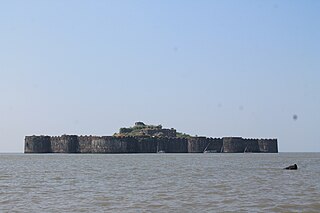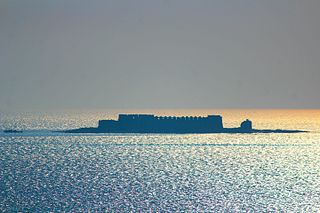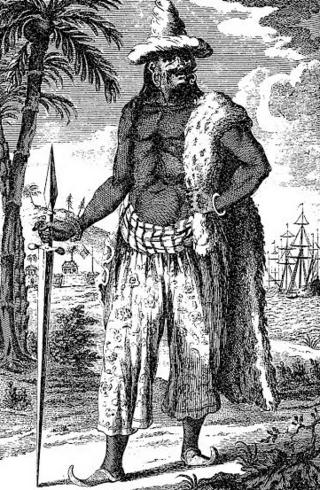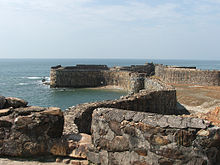
Sambhaji, also known as Shambhuraje was the second Chhatrapati of the Maratha Empire, ruling from 1681 to 1689. He was the eldest son of Shivaji, the founder of the Maratha Empire. Sambhaji's rule was largely shaped by the ongoing wars between the Maratha Empire and the Mughal Empire, as well as other neighbouring powers such as the Abyssinians of Janjira, Wadiyars of Mysore and the Portuguese Empire in Goa. After Sambhaji's execution by Aurangzeb, his brother Rajaram I succeeded him as the next Chhatrapati and continued the Mughal–Maratha Wars.

Kanhoji Angre, also known as Conajee Angria or Sarkhel Angré was a chief of the Maratha Navy in present-day India. Kanhoji became known for attacking and capturing European merchant ships and collecting jakat, seen by Europeans traders and colonists as ransoming of their crews. British, Dutch and Portuguese ships often fell victims to these raids.Despite attempts by the Portuguese and British to put an end to his privateering activities, Angre continued to capture and collect jakat from European merchant ships until his death in 1729. Kanhojikoli 's naval prowess in capturing dozens of European trading ships and avoiding capture has led to many historians to appraise Kanhoji as the most skilled Indian navy chief in the maritime history of India.

Shahu I was the fifth Chhatrapati of the Maratha Empire founded by his grandfather, Shivaji I. He was born into the Bhonsle family, and was the son of Sambhaji I and Yesubai. At a young age, he was taken into custody at the Siege of Raigad by Mughal emperor Aurangzeb, and held captive by the Mughals. He was released from captivity after the death of Aurangzeb in the hope of engineering an internecine struggle among the Maratha factions of Tarabai and Shahu. Raja Shahu emerged victorious in the bloody Battle of Khed and was crowned as Chhatrapati.

Balaji Vishwanath Bhat (1662–1720) was the first of a series of hereditary Peshwas hailing from the Bhat family who gained effective control of the Maratha Empire and the Mughal vassals of the Marathas during the early 18th century. Balaji Vishwanath assisted a young Maratha king Shahu to consolidate his grip on a kingdom that had been racked by civil war and persistently intruded on by the Mughals under Aurangzeb. He was called the Second Founder of the Maratha State. He secured a grant from the Mughal court that confirmed Shahu as the legitimate Mughal vassal, at the expense of his rival Sambhaji. Later, his son Bajirao I became the Peshwa.

Murud-Janjira is the local name of a famous fort and tourist spot situated on an island just off the coastal town of Murud, in the Raigad district of Maharashtra, India. Malik Ambar is credited with the construction of the Janjira Fort in the Murud Area of present-day Maharashtra India. After its construction in 1567 AD, the fort was key to the Sidis withstanding various invasion attempts by the Marathas, Mughals, and Portuguese to capture Janjira.

Suvarnadurg is a fort that is located between Mumbai and Goa on a small island in the Arabian Sea, near Harnai in Konkan, along the West Coast of India, in the Indian state of Maharashtra.
Murud is a town and a municipal council in Raigad district in the Indian state of Maharashtra. Situated at a distance of 150 km (93 mi) from Mumbai, Murud is a tourist destination. The Palace of Nawab is located in Murud. The palace was built in 1885 for administration purposes. The palace is still owned by the descendants of the Nawab and is a private property.

Kolaba Fort located at Alibag beach is an old fortified maritime base in Alibag, Konkan, India. It is situated in the sea at a distance of 1–2 km from the shores of Alibag, 35 km south of Mumbai, in the Konkan region of Maharashtra, India. It is a popular tourist destination and a protected monument.

Padmadurg, also known as Kasa fort, is one of five historical sea forts built by Chhatrapati Shivaji Maharaj and located in Raigad District Maharashtra, India. It was built by the Marathas to challenge another seaport, Janjira which was controlled by the Siddis.

Ramchandra Neelkanth Bawadekar (1650–1716), also known as Ramchandra Pant Amatya, served on the Council of 8 as the Finance Minister (Amatya) to Emperor (Chhatrapati) Shivaji, dating from 1674 to 1680. He then served as the Imperial Regent to four later emperors, namely Sambhaji, Rajaram, Shivaji II and Sambhaji II. He authored the Adnyapatra, a famous code of civil and military administration, and is renowned as one of the greatest civil administrators, political thinkers, diplomats and military strategists of the Maratha Empire.

Khanderi is an island with a fort, located south of Mumbai, along the coast of Maharashtra, India.

Vijaydurg, the oldest fort on the Sindhudurg coast, was constructed during the regime of Raja Bhoja II of the Shilahar dynasty and restructured by Chhatrapati Shivaji Maharaj.
Gowalkot is a small fort located on the southern bank of Vashishti River, about 10.0 km (6.2 mi) from Chiplun in Maharashtra, India. This fort is guarded by the river on three sides and a trench on the fourth side. Its population which includes Hindus, Muslims, and Buddhists. According to old natives of Gowalkot, the history of Gowalkot goes back to a King, who was Hindu and finally was converted in Muslim, his surname was "Chougle", and most of the land in Gowalkot is owned by the Chougle family. All other owner of land in Gowalkot must have either received the land as gift [or bought] from Chougle family must have lost in "kul kaida" a rule by the government.

The Battle of Vijaydurg was fought between Tulaji Angre, the Admiral of the Maratha Navy and the combined forces of the East India Company and the Maratha Confederacy led by Peshwa Balaji Bajirao in early 1756.

The Maratha–Portuguese War of 1683–1684 refers to the Mahratta invasion of the Portuguese-controlled portions of Goa and also the Bombay area of the north Konkan. The conflict between the Mahratta Confederacy and the Portuguese in Goa and Bombay, continued on various fronts in between 1683–1684.
Mughal invasion of Konkan (1684) was a part of the Deccan wars. It was a campaign launched by Mughal Emperor Aurangzeb to capture the Konkan region from the Maratha Empire under Sambhaji. The Mughal forces were led by Mu'azzam and Shahbuddin Khan. The harsh climate and the Maratha guerrilla strategy forced the numerically strong Mughal army into a slow retreat. The Maratha army suffered small losses in this unsuccessful campaign of Mughal Empire. In this war the Mughals were badly defeated by Marathas.

Tulaji Angre, called Tulajee Angria by English historians was the grand admiral of the Maratha Navy and ruler of Colaba State in modern-day India. Similar to his famous father Kanhoji Angre, he too was an extremely skilled admiral and attacked several European trading ships. His achievements and naval prowess are considered to be greater than that of his father by some scholars and chroniclers. On various occasions he fought against the English, Dutch, Siddis And Portuguese maritime Powers. However, he alienated himself from the Maratha Peshwa, Balaji Baji Rao which led to his capture by the East India Company and Peshwa's forces at the Battle of Vijaydurg in 1756.
Colaba State, also known as Culaba State or Angria's Colaba was a Kingdom and later princely state in India. It was founded by the famous Maratha Navy admiral Kanhoji Angre in 1698. The ruling family of the state, the Angre, were skilled seafarers who controlled the western coast of India from the late 17th century- to the first half of the 18th century, until the Maratha Peshwa Balaji Baji Rao destroyed the major portion of their navy in the Battle of Vijaydurg.

The Siege of Janjira was a military campaign undertaken by the Maratha Empire, commanded by Sambhaji, the second Maratha ruler, against the Siddis of Janjira in January 1682. The Maratha forces, led by Sambhaji, withdrew from Janjira to the Konkan region in response to Mughal attacks, leaving a contingent behind under the command of Dadaji Raghunath Deshpande. Despite their efforts, the Marathas were unable to capture the fort, and the Siddis pursued the retreating forces, plundering Maratha territories.

The Shivaji's invasions of Janjira were a series of military campaigns launched by the first Maratha ruler, Shivaji, against the Abyssinian rulers of the sea fortress of Janjira named Siddis between 1661 and 1676. The Marathas attacked the Janjira fort annually, and during the final siege of 1676, the Maratha Peshwa Moropant faced a counterattack by the Siddis, forcing the Marathas to retreat with heavy casualties.





























